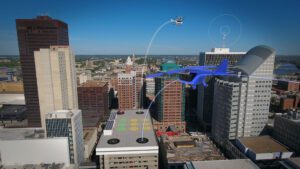NASA on Advanced Air Mobility Integration
 NASA’s Strategic Role in Integrating Advanced Air Mobility: Insights from Nancy Mendonca at AUVSI Xponential 2024
NASA’s Strategic Role in Integrating Advanced Air Mobility: Insights from Nancy Mendonca at AUVSI Xponential 2024
by DRONELIFE Contributing Editor Paul Rossi
During the AUVSI Xponential 2024 conference, I had the opportunity to sit down with Nancy Mendonca, the deputy NASA Advanced Air Mobility Mission integration manager. We discussed NASA‘s pivotal role in the government-led efforts to integrate advanced air mobility (AAM) solutions, such as drones and air taxis, into the U.S. transportation system. Here’s what I learned from our conversation about the ongoing collaborations and challenges in this rapidly evolving field.
Collaborative Efforts with the Department of Transportation
Mendonca highlighted that NASA is actively collaborating with the Department of Transportation (DOT) through the Advanced Air Mobility integration working group, which includes 22 federal agencies. This group is instrumental in shaping the strategy for the integration of AAM technologies into national airspace. “We are in the process of developing the first draft strategy which is scheduled to be complete around the end of May,” Mendonca shared. This strategy is a direct response to the U.S. Advanced Air Mobility Coordination and Leadership Act, aiming to create a unified approach among various government entities.
Addressing Key Challenges
When asked about the challenges in widespread adoption of AAM, Mendonca pointed out that community integration is paramount. “The transition from focusing solely on traditional stakeholders to engaging community stakeholders is critical for regional mobility,” she explained. NASA’s approach involves not just technical solutions but also societal integration, ensuring that AAM technologies are accepted and effectively utilized within communities.
Milestones Achieved Under the AAM Coordination and Leadership Act
Mendonca shared some of the noteworthy achievements under the AAM Coordination and Leadership Act. “One of our early steps included issuing a Request for Information (RFI) that received nearly 500 responses. This helped us gauge the pulse of the industry and public interest,” she stated. Furthermore, the coordination among over 20 federal agencies stands as a testament to the collaborative effort required to advance AAM technologies. “The upcoming first draft of our strategy will mark a significant milestone in our journey,” she added.
A Message to DroneLife.com Readers
For readers of DroneLife.com, Mendonca emphasized the importance of understanding the collaborative nature of NASA’s initiatives. “We are working not just with traditional aerospace sectors but also with the Department of Education and the Department of Labor, as well as with AFWERX, to help increase community awareness about AAM,” she said. This broad engagement is crucial for developing a workforce capable of supporting this new era of air mobility.
Our discussion with Nancy Mendonca at AUVSI Xponential 2024 shed light on the integral role NASA plays in fostering the development and integration of AAM technologies. With a focus on collaboration, community involvement, and strategic milestone planning, NASA is steering the future of transportation toward a more innovative and inclusive horizon.
Read more:

 Paul Rossi is the Chief Operations Officer and Chief Pilot atNine Ten Drones, a N. C.-based drone services company, training center, and reseller. Rossi is also the Outreach Coordinator for the North Carolina Chapter of AUVSI. A graduate of Embry Riddle Aeronautical University and the U.S. Army Aviation Logistics School, Rossi is passionate about the aviation industry. He holds both a private pilot’s license for manned aircraft and a Part 107 Remote Pilot’s Certificate. You can see more videos and product information on the Nine Ten Drones YouTube channel.
Paul Rossi is the Chief Operations Officer and Chief Pilot atNine Ten Drones, a N. C.-based drone services company, training center, and reseller. Rossi is also the Outreach Coordinator for the North Carolina Chapter of AUVSI. A graduate of Embry Riddle Aeronautical University and the U.S. Army Aviation Logistics School, Rossi is passionate about the aviation industry. He holds both a private pilot’s license for manned aircraft and a Part 107 Remote Pilot’s Certificate. You can see more videos and product information on the Nine Ten Drones YouTube channel.
Miriam McNabb is the Editor-in-Chief of DRONELIFE and CEO of JobForDrones, a professional drone services marketplace, and a fascinated observer of the emerging drone industry and the regulatory environment for drones. Miriam has penned over 3,000 articles focused on the commercial drone space and is an international speaker and recognized figure in the industry. Miriam has a degree from the University of Chicago and over 20 years of experience in high tech sales and marketing for new technologies.
For drone industry consulting or writing, Email Miriam.
TWITTER:@spaldingbarker
Subscribe to DroneLife here.

